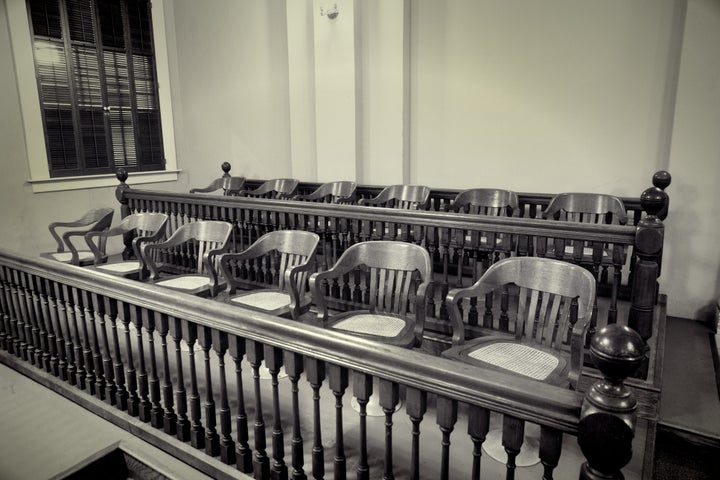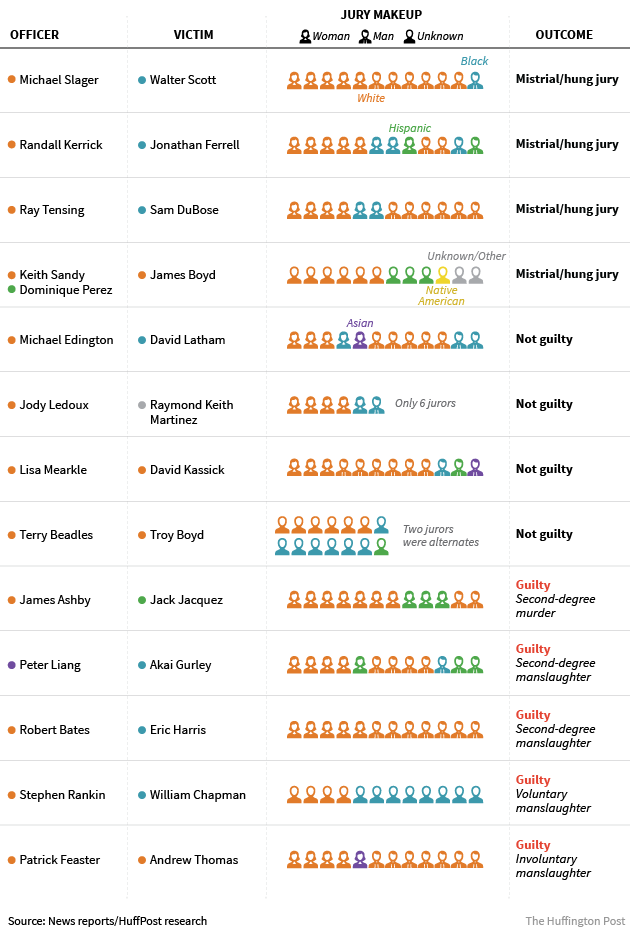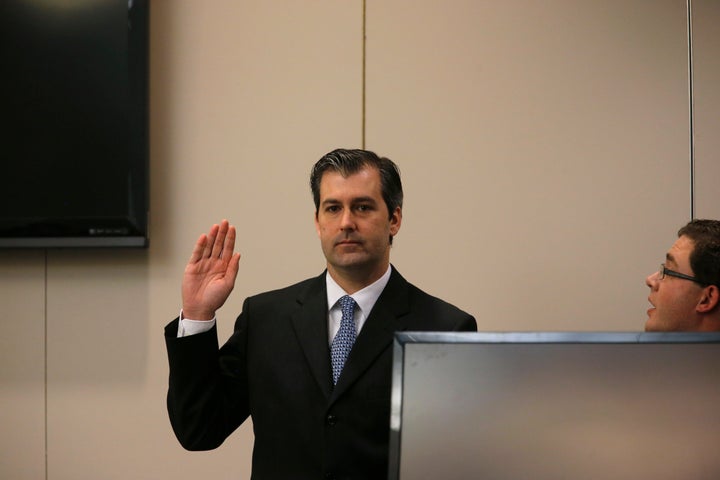
Police officers in the U.S. fatally shot at least 991 civilians in 2015, and, with just weeks left in the year, 2016 is likely to keep pace. The overwhelming majority of the officers involved in these incidents, which The Washington Post and The Guardian have been tracking, were never tried in court. Legal protections shielded officers from criminal liability in many cases, leading police officials or prosecutors to determine that the shootings were justified.
In the few instances in recent years in which police officers did go to trial for fatal shootings in the line of duty, juries have been unlikely to return a guilty verdict.
“Jurors are often reluctant to second-guess the split-second life-or-death decisions of police officers in violent street encounters while on duty,” said Philip Stinson, an associate professor of criminology at Ohio’s Bowling Green State University who has compiled nationwide data on the prosecution of officers facing murder or manslaughter charges for on-duty shootings since 2005.
While this trend is fairly consistent across juries, a Huffington Post investigation using Stinson’s research suggests the racial composition of juries may have influenced the outcomes in many of these cases. HuffPost obtained juror information for all 13 police shooting trials that have gone to a jury since August 2014 through reviews of news reports and interviews with court officials, attorneys and local reporters.
Our investigation found that majority-white juries decided 11 of those 13 cases, which represent those since Michael Brown’s death in Ferguson, Missouri, in August 2014. (In the Brown case, a grand jury ultimately declined to charge the officer, Darren Wilson.) As in Ferguson, at least eight of the cases HuffPost reviewed involved officers fatally shooting people of color. Of the 14 police officers tried in the 13 cases, one was Hispanic and one was Asian. The rest were white.
In nine of the 13 cases, one-third or fewer of the jurors represented a minority group. And in almost every case, the racial makeup of the jury did not reflect local demographics. Although jury pools are supposed to reflect a cross-section of the surrounding area, there is no requirement to seat a panel that looks like the community it’s representing.
That much was clear this month in South Carolina, where a nearly all-white jury deadlocked on charges of murder and manslaughter against former North Charleston police officer Michael Slager for the 2015 shooting death of Walter Scott. Scott, 50, was black, and although nearly 50 percent of North Charleston’s population is also black, only one of the 12 jurors was. Many suspected Slager’s defense attorneys had intentionally skewed the racial makeup of the jury.
A number of jurors in the Slager case were reportedly undecided heading into deliberations, with many considering the lesser charge of manslaughter over murder. But jury foreman Dorsey Montgomery, the lone African-American on the panel, told reporters that the doggedness of a single white juror who said he could not convict Slager, who is white, under any circumstance helped lead to the mistrial. The jury’s final vote was 10 in favor of handing down a voluntary manslaughter charge and two who voted not guilty. Prosecutors now say they’ll retry the case. Slager also still faces federal civil rights charges.

Attorneys have great influence over the racial composition of juries. In the process known as voir dire, they question prospective jurors about their personal backgrounds or positions on issues that could affect their ability to be impartial in a case. During this process, lawyers may strike a juror for cause if they determine he or she could not deliver a fair verdict. Attorneys are also given a number of so-called “peremptory strikes,” which typically allow them to eliminate jurors without needing to explain why.
A 1986 Supreme Court ruling made it unconstitutional for attorneys to dismiss potential jurors for reasons based upon race or gender. If the opposing counsel suspects a party has used its strikes in a discriminatory fashion, the attorneys can contest it using a Batson challenge, named after the Supreme Court decision. But it’s difficult to prove motivation.
“Without a smoking gun, it’s almost impossible to enforce the Batson provision,” said Patrick Bayer, a professor of economics at Duke University who has studied links between the race of a jury and the outcome of the trial.
Civil rights groups and legal scholars have criticized prosecutors for disproportionately excluding people of color from jury pools. But critics say it’s far too easy for attorneys representing either party to evade court restrictions by fabricating race-neutral explanations for striking a candidate.
“Race may be a predominant factor in these decisions, but it’s likely not the only factor,” said Stephen Bright, a lecturer at Yale Law School and the president of the Southern Center for Human Rights. “And how would a judge know? The fact of the matter is you can’t tell, so it’s a wholly inadequate remedy.”
Filling juries with a disproportionate number of white people could benefit law enforcement, as white Americans are more likely to express pro-law enforcement views than non-white Americans, and they are less likely to be acquainted with or sympathetic to issues of race and policing that many see as integral to these cases.
Sixty-eight percent of white respondents reported having favorable views of local police in a poll released in early December, compared with only 40 percent of African-Americans and 59 percent of Hispanics. In the same survey, just 35 percent of whites said police are too quick to use lethal force, compared with 73 percent of African-Americans and 54 percent of Hispanics. And 64 percent of whites were highly confident that their local police departments treat all racial groups equally, a position shared by just 31 percent of African-Americans and 42 percent of Hispanics.
Angel Harris, a staff attorney at the NAACP Legal Defense and Educational Fund, said these jury trends are troubling considering the significant racial disparities in the way Americans experience and interact with law enforcement. She’s concerned that minority groups are being systematically disenfranchised and removed from the judicial process.
“We’re dealing with police officers who are put in a very special position in our society, and if our society doesn’t have an equal say in how police officers should be performing and protecting and serving the community, then I think we’ve failed in that process,” said Harris.
In the Walter Scott case, there is plenty of suspicion that Slager’s attorneys would have motivation to eliminate black individuals from the jury pool. The release of the harrowing video of Scott’s death intensified an already protracted debate on the relationship between law enforcement and communities of color, and Scott’s name became a rallying cry for supporters of the Black Lives Matter movement and police reformers.
“If you’re this cop on trial in the killing of Walter Scott, you’re going to strike the black jurors because you’re afraid they’re going to rule against you,” said Bright.
Slager’s defense used seven of its nine strikes to remove people of color from contention.
When the prosecution challenged the defense’s strikes, Slager’s attorneys provided race-neutral reasons for the exclusions. One candidate had expressed concerns about spending time away from work, they said, and they felt another had inadequate education. Another potential juror had failed to properly complete an answer on the questionnaire. The prosecution eventually accepted the defense’s explanations and dropped the challenge.
“Our criteria was cross-cultural, cross-racial and consistent,” said Andy Savage, Slager’s defense attorney. “We had race-neutral, ethnic-neutral and gender-neutral reasons.”
Savage’s justifications may have been legitimate, but critics say attorneys may not always apply these criteria equally when considering whether to strike white potential jurors.
“Attorneys use seemingly innocuous reasons to exclude people of color, but if you actually surveyed the entire jury, you’d likely have white jurors who have the same opinions or same sort of reasons that could have led to them being excluded,” said Harris.
Savage said that wasn’t the case in their strikes in the Slager case and, had these inconsistencies existed, the prosecution likely would have seized on them during its challenge.
Whether deliberate or not, the result of the selection process was to seat a jury that was less likely to consider broader issues of race and policing that had come to define Scott’s shooting. Perhaps as a result, both the defense and the prosecution argued throughout the trial that race didn’t play a part in the fatal confrontation.
Jurors in Slager’s trial ended up avoiding discussions of race during deliberations, jury foreman Montgomery told the “Today” show.
That it was not discussed in the trial doesn’t mean issues of race weren’t relevant to Scott’s death. Ample scholarship suggests police ― and Americans more generally ― are more likely to exaggerate the threat they face from black individuals. Officers also are more likely to use force, including lethal force, on black suspects, even when the suspects are unarmed, according to research by the Center for Policing Equity, a law enforcement think tank. White jurors may be less inclined to discuss race when deliberating charges against an officer simply because it doesn’t occur to them.
“When you have a jury that’s all white, you’re not going to have a robust conversation about how implicit bias can come into play in a police officer assuming that someone is much more dangerous than they really are,” Harris said.

According to Bayer, “White people are more likely to trust the police or to be willing to take their word for the fear they say they feel.” And these beliefs would likely remain even if jurors were considering a case in which a white officer had shot a white victim.
The jury selection process is supposed to allow attorneys to sniff out these sorts of biases. But an officer’s defense only needs to sow doubt in the minds of a few jurors to succeed, and filling a jury with as many white people as possible could work to their advantage.
That doesn’t guarantee legal victory for the police officer, and with so few police-involved shootings going to trial, it’s impossible to discern a clear correlation between the race of jurors and the outcome of those cases, said Bayer.
In the cases HuffPost examined, there was no clear connection between the racial composition of a jury and the likelihood of a guilty verdict. Majority-white juries were responsible for returning guilty verdicts in four out of the five cases that ended in convictions. The only majority-black jury among these cases also returned a guilty verdict, against former Portsmouth, Virginia, police officer Stephen Rankin, who is white, in the shooting of William Chapman, an African-American.
An all-white jury found former Tulsa County, Oklahoma, reserve deputy Robert Bates guilty of second-degree manslaughter in the fatal shooting of Eric Harris in April; Bates is white and Harris was black. And one of the most diverse juries among the cases HuffPost examined ― a panel that included six African-Americans and one Hispanic person ― returned a verdict of not guilty earlier this year in the trial of former sheriff’s deputy Terry Beadles in Pike County, Mississippi, a white officer who shot a white man.
The individual facts of each case matter, and a juror’s race alone does not determine impartially.
But the outsized influence of heavily white juries can prejudice outcomes in favor of police, say critics, and is reflective of a criminal justice system that fails to fully represent and include communities of color.
“The whole system doesn’t look like the people who come through it,” said Bright.
He noted that 95 percent of the nation’s elected state and local prosecutors are white, according to a 2014 study, along with 80 percent of state judges. “When even the jurors don’t look like the people coming before them as parties and witnesses, how can courts have any credibility with the community?”
Sign up for the HuffPost Must Reads newsletter. Each Sunday, we will bring you the best original reporting, longform writing and breaking news from The Huffington Post and around the web, plus behind-the-scenes looks at how it’s all made. Click here to sign up!
